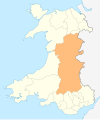Wye Valley Walk
| Wye Valley Walk | |
|---|---|
 Part of the Wye Valley Walk following the formerLydbrook Junctionto MonmouthRailway | |
| Length | 219 km (136 mi) |
| Designation | Long-distance trail |
| Trailheads | Chepstow Plynlimon |
| Use | Hiking |
| Highest point | Plynlimon, 752 m (2,467 ft) |
| Season | All year |
TheWye ValleyWalk(Welsh:Llwybr Dyffryn Gwy) is along distance footpathinWalesandEnglandfollowing the course of theRiver Wye.
History[edit]
In 1975 the Wye Valley Walk opened with a 14-mile (23 km) stretch betweenSt. ArvansandMonmouth.[1]Further stretches were added, leading to it becoming a 34-mile (55 km) footpath by 1981.[1]During the 1980s, gaps betweenRoss-on-Wye,Hay-on-WyeandRhayaderwere integrated into the pathway, forming a 112-mile (180 km) walk reaching from near the river's mouth atChepstowinMonmouthshire,toRhayaderinMid Wales.[1]
In September 2002, the route was finally extended to start or finish inCoed Hafren,having passed within viewing distance of the source of theRiver WyeonPlynlimonnearAberystwyth,a total of 136 miles (219 km).[1]
The route[edit]



The Wye Valley Walk is marked out by circular yellowwaymarkarrows,finger posts,and signs showing the path'slogo,a leapingsalmon.Most of the route followsPublic Rights of Way.Some parts arepermissive pathswhere owners have agreed for them to be used. Parts of Plynlimon are open countryside in which there is aright to roamestablished by theCountryside and Rights of Way Act 2000.[2]
The route passes through Chepstow, theWye ValleyAONB,Tintern,Monmouth,Ross-on-Wye,Symonds Yat,Hereford,Hay-on-Wye,Builth Wells,Rhayader,andLlangurigto Plynlimon.
The route of the Wye Valley Walk can be broken into 17 stages,[3]though the entire walk is often walked in seven day-length sections from Chepstow to Plynlimon, or vice versa.[4]
Days and sections[edit]
Days and sections* described in the textThe Wye Valley Walk,and The Wye Valley Walk website, both by The Wye Valley Partnership.[3][4]
Day 1[edit]
- Section 1:Chepstow CastletoTintern Abbey– 6 miles (10 km)
- Section 2: Tintern Abbey to Monmouth – 10 miles (16 km)
Day 2[edit]
- Section 1: Monmouth to Symonds Yat – 6 miles (10 km)
- Section 2: Symonds Yat toKerne Bridge– 8 miles (13 km)
- Section 3: Kerne Bridge to Ross-on-Wye – 6 miles (10 km)
Day 3[edit]
- Section 1: Ross-on-Wye toFownhope– 11 miles (18 km)
- Section 2: Fownhope to Hereford – 7 miles (11 km)
Day 4[edit]
- Section 1: Hereford toByford– 10 miles (16 km)
- Section 2: Byford toBredwardine– 5 miles (8 km)
- Section 3: Bredwardine to Hay-on-Wye – 9 miles (14 km)
Day 5[edit]
- Section 1: Hay-on-Wye toGlasbury– 5 miles (8 km)
- Section 2: Glasbury toErwood– 9 miles (14 km)
- Section 3: Erwood to Builth Wells – 7 miles (11 km)
Day 6[edit]
- Section 1: Builth Wells toNewbridge-on-Wye– 7 miles (11 km)
- Section 2: Newbridge-on-Wye to Rhayader – 10 miles (16 km)
Day 7[edit]
- Section 1: Rhayader to Llangurig – 12 miles (19 km)
- Section 2: Llangurig to Rhyd-y-benwch (Plynlimon) – 12 miles (19 km)
*miles and km rounded to whole numbers
Landmarks[edit]
The Wye Valley Walk passes the following notable landmarks:
Rail access[edit]
The following stations have services provided byTransport for Waleswhich can be used to connect with the Wye Valley Walk:
References[edit]
- ^abcdWye Valley Walk Partnership (2011).The Wye Valley Walk.Cicerone. p. 2.ISBN978-1-85284-625-1.
- ^The Wye Valley Walk: The essentials.Retrieved 12 April 2014
- ^abWye Valley Partnership (2011).The Wye Valley Walk.Cicerone. p. 4.ISBN978-1-85284-625-1.
- ^ab"Wye Valley Walk Interactive Maps".The Wye Valley Walk Partnership.Retrieved3 April2014.

